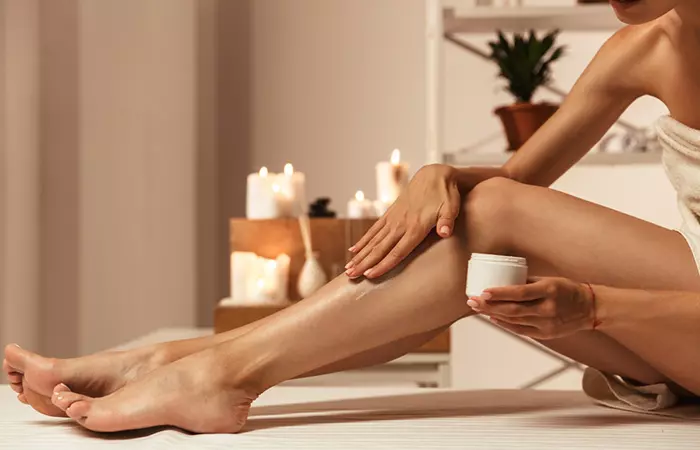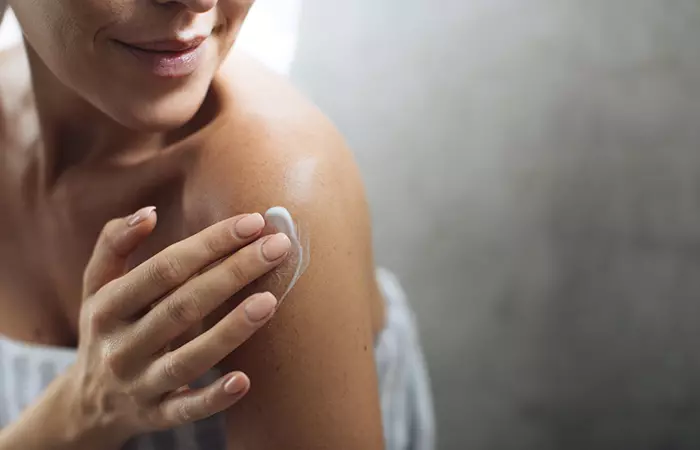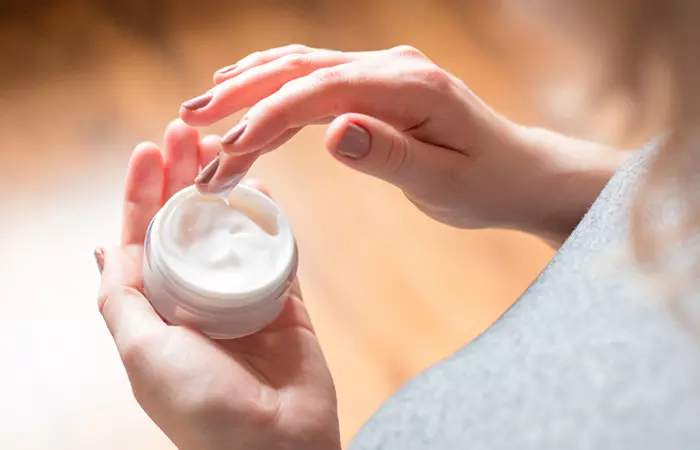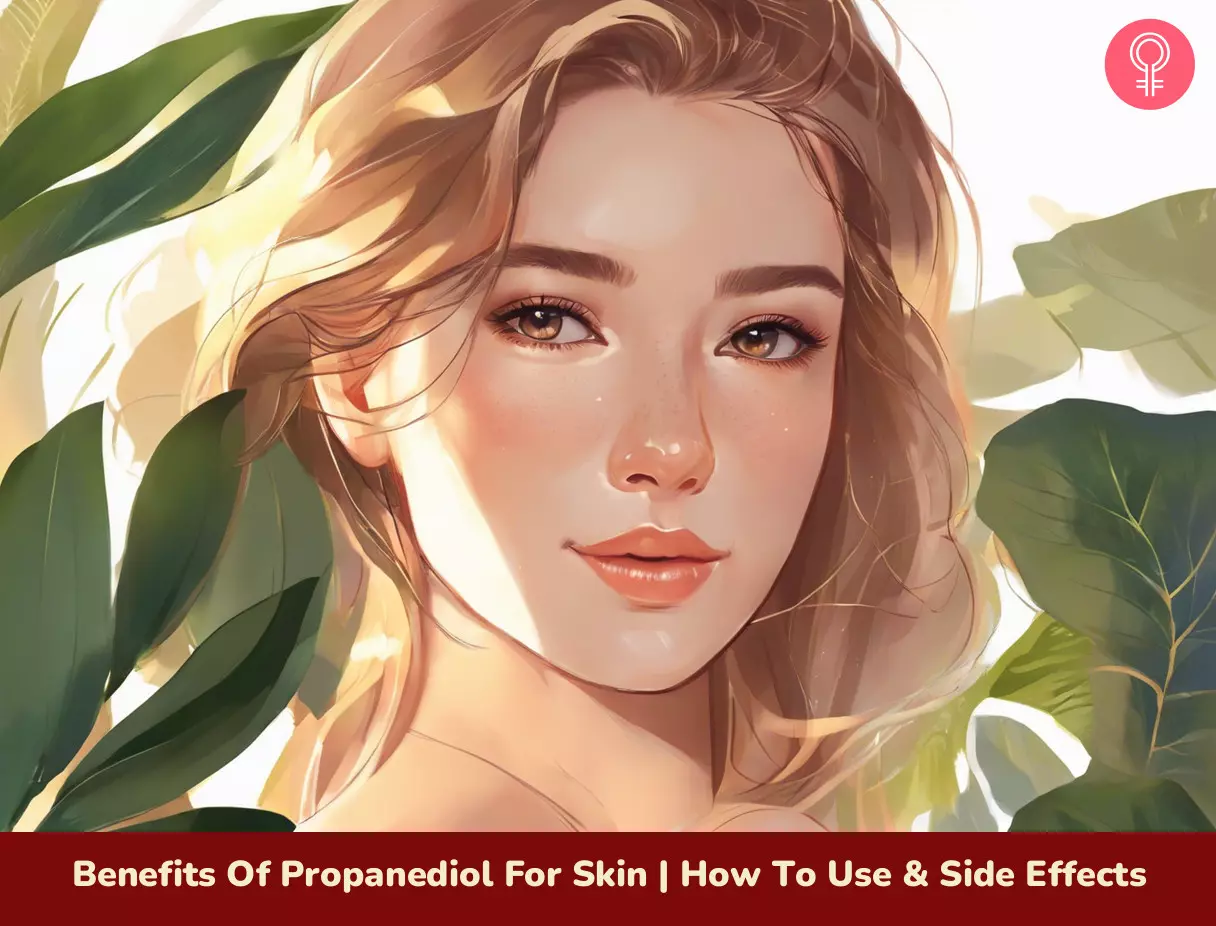Propanediol: What Is It And Is It Safe In Skin Care?
Propanediol is a colorless and thick glycol liquid extracted from corn glucose or corn sugar. It is widely incorporated as an ingredient in skin care products. It is most likely used in lotions, toners, cleansers, and other skin care products. Propanediol is proven to be a safer alternative to propylene glycol (another ingredient used in skin care). What Are Its Benefits? Acts as a good emollient, helps in better absorption of skincare products and has an anti-aging effect on the skin. Who Can Use It? All except those who are allergic to corn. How Often? As part of one’s everyday skincare routine. Caution It may cause allergic reactions or skin irritation in some individuals.
Using propylene glycol for the skin is controversial due to its toxic chemical composition. Though rare, it may cause skin irritation and increase the risk of certain cancers (1). Propanediol shares the same chemical formula and effectiveness as propylene glycol, but is known to be a much safer alternative. Propanediol works wonderfully on your skin when used in moderate amounts. It helps retain skin moisture and penetrates into the skin easily. It also softens skin. Propanediol is recognized as a safe ingredient that can be applied to your skin. In fact, it is also safe for use in food products (2). In most cases, propanediol has not shown any signs of skin irritation, allergic reactions, or skin sensitivity. Moreover, it comes from a natural source of ingredients and is safer than propylene glycol.
Benefits Of Propanediol For Skin Care
Propanediol is widely used in the skin care and cosmetic industry for its effectiveness and added benefits. Here is how it can benefit your skin.
1. Acts As A Great Emollient
Propanediol is known for its ability to soothe, soften, and enrich skin. This natural emollient works as a protective skin barrier and helps reduce water loss by increasing skin hydration levels. Hence, you will find propanediol in lotions and moisturizers for its smoothing and soothing properties.
2. May Work As An Excellent Solvent
Propanediol may help break down stubborn and hard ingredients like salicylic acid or ascorbic acid and promote better absorption. It is for this reason used in many cosmetic compositions (3).
3. May Have Anti-Aging Properties
With age, the efficacy of natural ingredients or humectants like amino acids, lactates, sugar, and salts that help maintain skin hydration levels reduce. This can lead to signs of aging, including wrinkles and dry skin. Propanediol can be used as an antiaging agent as its hydrating properties can help increase skin hydration levels (4).
4. May Promote Product Absorption
Propanediol, in combination with chemical penetration enhancers, can help the necessary ingredients reach deep within the skin. Propanediol also acts as an excellent solvent and helps dissolve active ingredients, like salicylic acid and ferulic acid, to further enhance skin health.
5. Has Preservative Properties
Propanediol is a natural preservative. It helps combat issues like decomposition and chemical changes in a product. Hence, it is used in many skin care products to retain their freshness.
6. May Enhance Texture Of Skin Care Products
Propanediol may help enhance the texture and consistency of various skin care products. Due to its easily dissolvable, preservation-friendly, and soothing properties, it is added to various skin care products to increase their foamability and texture. This ingredient also reduces the stickiness, consistency, and viscosity of the product to enable it to be applied easily.
How Does It Appear On The Ingredients Lists?
Propanediol can be easily spotted at the back of lotion bottles, moisturizers, serums, cleansers, and toners. It can be found as any of the following terms:
1,3-propanediol trimethylene glycol methyl propanediol propane-1,3-diol 1,3-dihydroxy propane 2-deoxyglycerol
While propanediol has advantages in skin care, it may also have certain adverse effects.
Does It Have Any Side Effects?
Although propanediol is recognized as a safe ingredient for use on skin, it may not suit certain individuals or those allergic to the ingredient. This would usually manifest as skin irritation. Low and moderate concentrations of propanediol have not caused any harm to anyone. Talk to your dermatologist for the ideal dosage.
Who Should Use It?
Propanediol can be prescribed to people who fall under the below criteria:
Propanediol can do wonders for people with acne-prone skin. Its deep cleansing properties help remove the excess oil and dirt on your face and keep pores from getting clogged.
People who are not sensitive to the composition should use propanediol-infused skincare products. Perform a patch test to know if you are sensitive to the ingredient.
How To Use It?
Propanediol is combined with different ingredients and skin formulations – and no one specific method or application is followed to use propanediol. The usage and application entirely depend on the product, as it is widely used in many skin care products like toners, cleansers, moisturizers, serums, etc. Hence, consult your dermatologist before using any such products.
How Often Can We Use It?
Propanediol can be a part of your everyday skin routine. However, those with sensitive skin are suggested to speak to their dermatologist before using it.
Works Well With
Propanediol is used in a variety of skin care products. It is also used in combination with various other skin care ingredients. While there is no one specific combination that works exceptionally well, certain combinations seem to help heal and soothe the skin. Propanediol is seen in combination with witch hazel, salicylic acid, AHAsi Short for alpha-hydroxy acids, a group of acids derived from plants and animals that help exfoliate the skin and even out the skin tone. , sodium hyaluronatei A salt form of hyaluronic acid that helps moisturize the skin, reduce signs of aging, and heal wounds. , antioxidants, peptides, bioflavonoidsi Compounds found in plants that help boost the immune system and improve blood circulation and heart health. , tea-tree oil, and ascorbic acid. These are seen in a multitude of toners, serums, lotions, moisturizers, and cleansers. Just like propanediol, glycerin is a common ingredient used in skin care and beauty products. Let us compare them below.
Propanediol Vs. Glycerin
Like propanediol, glycerin is a humectant that helps the skin attract moisture from the environment and retain it to make it appear plump and moisturized. Both these ingredients are comparatively safe for the skin. Where propanediol can help enhance the texture and consistency of skin care products, glycerin is mainly used in moisturizers, lotions, and creams for hydration. The major difference between the two lies in their texture. Propanediol has a lighter and less sticky texture, whereas glycerin has a thick and slightly sticky texture. Therefore, the choice between the two mainly depends on your skin type. If you have oily skin, or you prefer a lighter texture, propanediol may be the better choice for you. Hence, we can safely conclude that it works well with most ingredients. Is propanediol cancerous? No, propanediol (chemically known as 1,3-propanediol) is considered safe in cosmetic applications. It is commonly confused with propylene glycol (1,2-propanediol), which has been found to have carcinogenic effectsi Substances or agents that can increase the risk of cancer by damaging DNA or changing chemical reactions in the cells. in high concentrations (1). Is propanediol vegan? Propandediol is likely vegan friendly as it is primarily derived from corn glucose. Does propanediol mix with water? Yes, propanediol is soluble as well as a great solvent. It mixes well with water to form an uniform solution.
Illustration: Benefits Of Propanediol For Skin | How To Use & Side Effects












